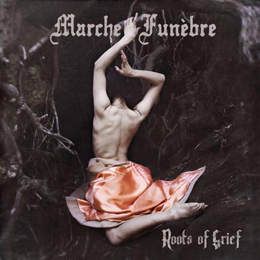
Belgium’s Marche Funèbre were formed more than six years ago with the intention to pay tribute to the Old School Doom-Death scene. Both the EP Norizon (2009) and the full length To Drown (2010) (also released via Shiver) proved that this band indeed did pay honour to the earliest years with grandeur and conviction. Of course the Lowlands (i.e. Belgium and Holland) are protagonists when it comes to the melodic / melancholic identification of Traditional Doom-Death Metal, but it won’t mean that any band succeeds to perform this specific approach with glory. With both former releases, however, Marche Funèbre did. In mean time, the band was able to play live with same-minded acts like Faal, Pantheist, Officium Triste, Thurisaz (to remain in between the borders of the Lowlands), or Saturnus, Before The Rain, Isole, NovemberS Doom, Evoken and many more.
In Spring 2013, the band (current line-up: Arne Vandenhoeck-v, Boris Iolis-b, Kurt Blommé-g, Dennis Lefebvre-d, and Peter Egberghs-g) entered the Mechelen-based Motormusic Studio to record the seven tracks that are now gathered under the title Roots Of Grief. The album lasts for more than an hour: four tracks out of seven last longer than ten minutes, two of them in between five and ten (and one title 1:26), but it is not that strange, as you evidently know.
In general, Roots Of Grief goes on in the vein of To Drown. The album opens with These Fevered Days (13:34), which starts extremely promising, combining elements from Suicidal Black, Traditional Doom-Death, and Funeral Doom Metal. But Marche Funèbre have some characteristic elements, like the use of clean vocals, which are part of this track, and all others as well. However, the funereal and pounding heaviness (especially when it comes to the rhythmic riffs) of this song is stronger than ever before. Further on, there are several changes in tempo and song structure, melody and vocal contribution, which makes the variety very interesting. Also the timeless approach is worth mentioning: the tradition of the Old School mixed with modern twists (not of the progressive or so-called Post-kind, however!) drapes the whole in a trans-cosmic veil of timelessness. And besides different types of grunt and clean vocals (varying from harmonious to quasi-chanting), there are some blackish screams too, which are one of the elements that make the border with the Black-oriented scene to fade away. Damn yes, this album is a worthy successor of To Drown, with so many similarities, yet at the same time this material is much more intense, professional (song writing as well as performance), and varied.
FYI: track as from the third track, the album comes as a conceptual entity, with those five songs gathered under the moniker of La Marche Funèbre.
